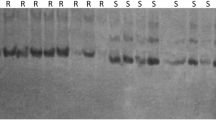Abstract
Outcrossing or cross hybridization is a potential concern in herbicide-resistant crop management strategies such as in the Clearfield™ rice system. Recent studies have shown that the mutated acetolactate synthase (ALS) gene that confers resistance to imazethapyr (Newpath) herbicide can be transferred from Clearfield rice cultivars via cross pollination under field conditions to weedy red rice. Resistance of commercial Clearfield rice cultivars to imazethapyr is due to the presence of two point mutations in the ALS gene that result in amino acid substitutions from serine to asparagine (S to D) and glycine to glutamic acid (G to E). We report here development of a DNA-based method that involves application of allele-specific PCR assays to distinguish herbicide-susceptible and resistant ALS alleles in either homozygous or heterozygous genotypes produced from natural outcrosses between Clearfield varieties CL121, CL141, CL161 and weedy red rice. PCR assays that can distinguish between the homozygous and heterozygous imazethapyr-resistant S653D and G654E SNP alleles of the rice ALS gene were developed and evaluated. A total of 483 individual red rice plants were successfully screened for the presence of S653D SNP and another 145 F2 individuals from natural red rice × CL121 hybridizations were screened for the presence of the G654E SNP. The PCR-based assays produced during this study are simple, rapid, inexpensive, reproducible and require only standard PCR and electrophoretic instruments that can be applied toward outcrossing evaluation and effective weed management strategies for the Clearfield crop system.




Similar content being viewed by others
References
Chen LJ, Lee DS, Song ZP et al (2004) Gene flow from cultivated rice (Oryza sativa) to its weedy and wild relatives. Ann Bot 93:67–73
Corbett CL (2004) DNA-based diagnostic tests for the detection of acetolactate synthase-inhibiting herbicide resistance in Amaranthus sp. MSc Thesis. University of Guelph
Corbett CL, Tardif FJ (2006) Detection of resistance to acetolactate synthase inhibitors in weeds with emphasis on DNA-based techniques: a review. Pest Manag Sci 62:584–597
Dillon TL, Talbert RE, Baldwin FL (2001) A three year overview of weed control in Clearfield rice. Proc South Weed Sci Soc 54:43
Estorninos LE Jr, Gealy DR, Dillon TL et al (2002) Determination of hybridization between rice and red rice using four microsatellite markers. Proc South Weed Sci Soc 55:197–198
Gealy DR, Tai TH, Sneller CH (2002) Identification of red rice, rice, and hybrid populations using microsatellite markers. Weed Sci 50:333–339
Gealy DR, Mitten DH, Rutger JN (2003) Gene flow between red rice (Oryza sativa) and herbicide resistant rice (O. sativa): implications for weed management. Weed Tech 17:627–645
Gealy DR, Yan W, Rutger JN (2006) Red rice (Oryza sativa) plant types affect growth, coloration, and flowering characteristics of first and second generation crosses with rice. Weed Tech 20:839–852
Hayashi K, Hashimoto N, Daigen M et al (2004) Development of PCR-based SNP markers for rice blast resistance genes at the Piz locus. Theor Appl Genet 108:1212–1220
Heap I (2007) The international survey of herbicide resistant weeds. Available via http://www.weedscience.org. Accessed 10 January 2008
Madsen KH, Valverde BE, Jensen JE (2002) Risk assessment of herbicide-resistant crops: a Latin American perspective using rice (Oryza sativa) as a model. Weed Tech 16:215–223
Messeguer J, Marfa V, Catala MM et al (2004) A field study of pollen-mediated gene flow from Mediterranean GM rice to conventional rice and the red rice weed. Mol Breed 13:103–112
Patzoldt WL, Tranel PJ (2002) Molecular analysis of cloransulam resistance in a population of giant ragweed. Weed Sci 50:299–305
Patzoldt WL, Tranel PJ (2003) Imidazolinone-specific resistance in twp Illinois tall waterhump (Amaranthus tuberculatus) biotypes. Proc Weed Sci Soc Am 43:90
Song ZP, Lu BR, Zhu YW et al (2003) Gene flow from cultivated rice to the wild species Oryza rufipogon under experimental field conditions. New Phytol 157:657–665
Steele GL, Chandler JM, McCauley GN (2002) Control of red rice (Oryza sativa) in imidazolinone-tolerant rice (O sativa). Weed Tech 16:627–630
Tan S, Evans RR, Dahmer ML et al (2005) Imidazolinone-tolerant crops: history, current status and future. Pest Manag Sci 61:246–257
Tan S, Evans R, Singh B (2006) Herbicidal inhibitors of amino acid biosynthesis and herbicide tolerant crops. Amino Acids 30:195–204
Tranel PJ, Wright TR (2002) Resistance of weeds to ALS-inhibiting herbicides: what have we learned. Weed Sci 50:700–712
Wagner J, Haas HU, Hurle K (2002) Identification of ALS inhibitor-resistant Amaranthus biotypes using polymerase chain reaction amplification of specific alleles. Weed Res 42:280–286
Wang F, Yuan QH, Shi L et al (2006) A large-scale field study of transgene flow from cultivated rice (Oryza sativa) to common wild rice (O. rufipogon) and barnyard grass (Echinochloa crusgalli). Plant Biotechnol J 4:667–676
Zhang NY, Linscombe S, Oard J (2003a) Out-crossing frequency and genetic analysis of hybrids between transgenic glufosinate herbicide-resistant rice and the weed, red rice. Euphytica 130:35–45
Zhang W, Gianibelli MC, Ma W et al (2003b) Identification of SNPs and development of allele-specific PCR markers for γ-gliadin alleles in Triticum aestivum. Theor Appl Genet 107:130–138
Zhang W, Linscombe SD, Webster E et al (2006) Risk assessment of the transfer of imazethapyr herbicide tolerance from Clearfield rice to red rice (Oryza sativa). Euphytica 152:75–86
Acknowledgements
We thank the LSU AgCenter Biotechnology Education for Students and Teachers (BEST) program for partial funding of this research.
Author information
Authors and Affiliations
Corresponding author
Rights and permissions
About this article
Cite this article
Kadaru, S., Zhang, W., Yadav, A. et al. Development and application of allele-specific PCR assays for imazethapyr resistance in rice (Oryza sativa). Euphytica 160, 431–438 (2008). https://doi.org/10.1007/s10681-008-9662-0
Received:
Accepted:
Published:
Issue Date:
DOI: https://doi.org/10.1007/s10681-008-9662-0




